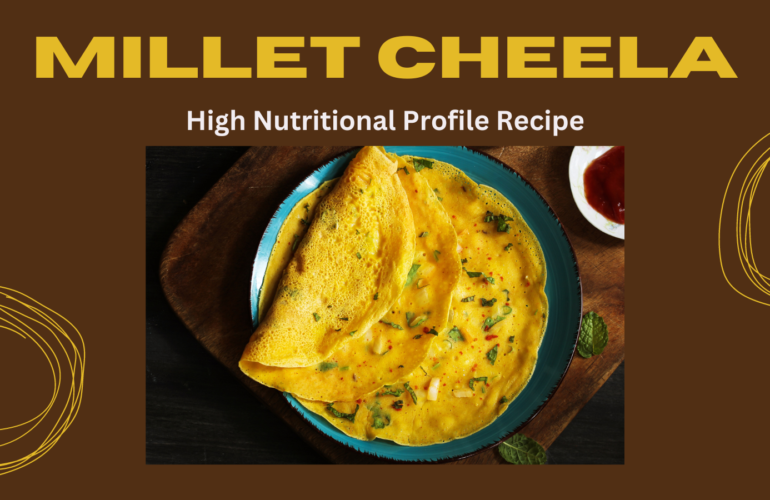Millet Cheela is not only a delicious and healthy breakfast option, but it’s also an excellent way to incorporate millets into your diet. Did you know that millets are among the oldest cultivated crops in the world and have been grown for over 10,000 years? Millets are a group of small-seeded grains that are gluten-free and are a rich source of nutrients like protein, fiber, and essential vitamins and minerals.
In fact, millets are considered to be one of the most nutritious cereals available and have several health benefits. For instance, millets have a low glycemic index, which means they can help regulate blood sugar levels and reduce the risk of type-2 diabetes. Millets are also rich in antioxidants, which can help prevent several chronic diseases.
This Millet Cheela recipe combines the goodness of millets with a variety of vegetables and spices, making it a nutritious and tasty breakfast option. With ingredients like spinach, carrots, onions, and tomatoes, this recipe not only adds flavor and texture but also boosts the nutritional value of the dish. So, whether you’re looking for a healthy breakfast option or simply want to explore the world of millets, this Millet Cheela recipe is definitely worth a try!
Ingredients
| Millet flour | 1/2 cup |
| Water | 1/4 cup |
| Onion | 1/4 cup |
| Tomato | 1/4 cup |
| Carrot | 1/4 cup |
| Spinach | 1/4 cup |
| Ginger | 1/2 tsp. |
| Cumin seeds | 1/2 tsp. |
| Coriander powder | 1/2 tsp. |
| Turmeric powder | 1/4 tsp. |
| Salt | To taste. |
| Oil | For cooking |
Directions
- In a mixing bowl, combine the millet flour, water, and salt. Mix well until the batter is smooth.
- Add in the chopped onions, tomatoes, grated carrots, chopped spinach, grated ginger, cumin seeds, coriander powder, and turmeric powder. Mix well to combine.
- Heat a non-stick pan over medium heat. Once hot, pour a ladleful of the batter onto the center of the pan.
- Using the back of the ladle, spread the batter in a circular motion to form a thin crepe.
- Drizzle some oil around the edges of the cheela and cook for 1-2 minutes or until the edges start to turn golden brown.
- Flip the cheela and cook for another 1-2 minutes until it’s fully cooked and crispy.
- Transfer the cooked cheela to a plate and repeat the process with the remaining batter.
- Serve hot with your favorite chutney or yogurt. Enjoy!
Nutritional Information
- Millet flour is a good source of protein, fiber, iron, magnesium, and vitamin B6.
- Onions are a good source of vitamin C, vitamin B6, and dietary fiber. They also contain antioxidants that can help protect against chronic diseases.
- Tomatoes are a rich source of vitamin C, vitamin K, and potassium. They also contain lycopene, an antioxidant that can help reduce the risk of heart disease and certain types of cancer.
- Carrots are an excellent source of vitamin A, vitamin K, and potassium. They also contain beta-carotene, an antioxidant that can improve eye health and reduce the risk of certain cancers.
- Spinach is a nutritional powerhouse and is loaded with vitamins A, C, and K, as well as iron, magnesium, and potassium. It’s also a good source of antioxidants that can help protect against several chronic diseases.
- Ginger contains several bioactive compounds that have anti-inflammatory and antioxidant properties. It’s also known for its ability to aid digestion and reduce nausea.
- Cumin seeds are a good source of iron, manganese, and calcium. They also contain antioxidants that can help protect against oxidative stress.
- Coriander powder is rich in antioxidants and has anti-inflammatory properties. It’s also a good source of dietary fiber and several essential vitamins and minerals.
- Turmeric powder is loaded with curcumin, a compound with powerful anti-inflammatory and antioxidant properties. It’s also been shown to improve brain function and reduce the risk of several chronic diseases.
Health Benefits of Consuming Millets
- Rich in nutrients: Millets are a good source of protein, fiber, essential vitamins and minerals, and antioxidants.
- Gluten-free: Millets are naturally gluten-free, making them a great alternative for people with gluten intolerance or celiac disease.
- Low glycemic index: Millets have a low glycemic index, which means they are slowly digested and absorbed, leading to a gradual rise in blood sugar levels. This makes millets a good choice for people with diabetes or those at risk of developing diabetes.
- Digestive health: The high fiber content in millets can help improve digestive health by promoting regular bowel movements and reducing the risk of constipation.
- Heart health: Millets contain several nutrients like magnesium, potassium, and fiber that can help lower blood pressure and cholesterol levels, thus reducing the risk of heart disease.
- Weight management: Millets are low in calories and high in fiber, which can help reduce appetite and promote weight loss.
- Anti-inflammatory: Millets contain several compounds that have anti-inflammatory properties, which can help reduce inflammation and the risk of chronic diseases like arthritis and cancer.
- Bone health: Millets are a good source of calcium, phosphorus, and magnesium, which are essential for strong and healthy bones.
Nutritional Calculations
| Calories | Carbohydrates | Protein | Fat |
| 82 Kcal | 15.1 gm | 3 gm | 1.2 gm |
Serving= 1
Overall, this recipe is a great way to incorporate millets and vegetables into your diet while satisfying your taste buds.
